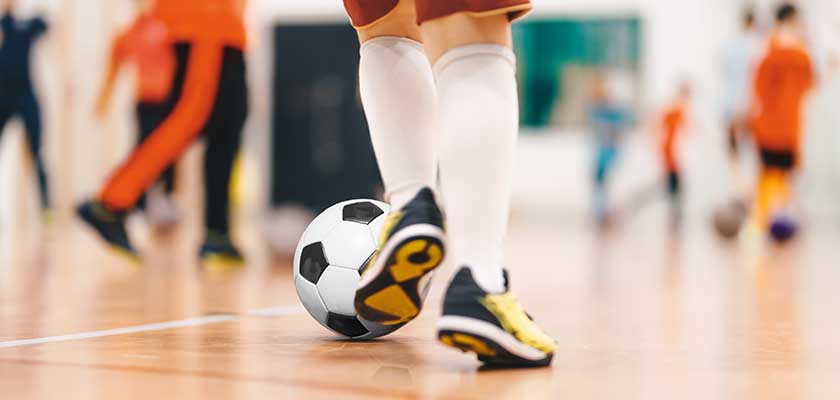Futsal, an exciting sport that mixes skill, strategy and a lot of physical strength, is one of the most popular sports in the world.
Created in Uruguay, the game is very similar to traditional football, but with a few peculiarities that make it unique.
In this complete and up-to-date guide, we’ll explain everything about futsal, including its origins, rules, fundamentals, players’ positions and curiosities.
This way, you’ll be able to follow the matches of the most famous national and international tournaments on the planet without getting lost.
Check it out 👇
What is futsal?
Futsal is a sport that originated from the adaptation of field football to indoor environments such as gyms and arenas.
The name of the sport is a combination of the words “football” and “indoor”, indicating its nature of being played on indoor courts with small dimensions.
Futsal matches involve two teams, each made up of five players, including a goalkeeper. The game is played in a rectangular space with specific markings. In addition, the ball used is smaller and heavier compared to the ball used in traditional football.
Matches are divided into two halves, usually of 20 minutes each, with a rest break between the two periods.
Despite these differences, the objective remains the same: to score with your feet. At the end of regulation time, the match is won by whoever has scored the most goals.
How did futsal come about?
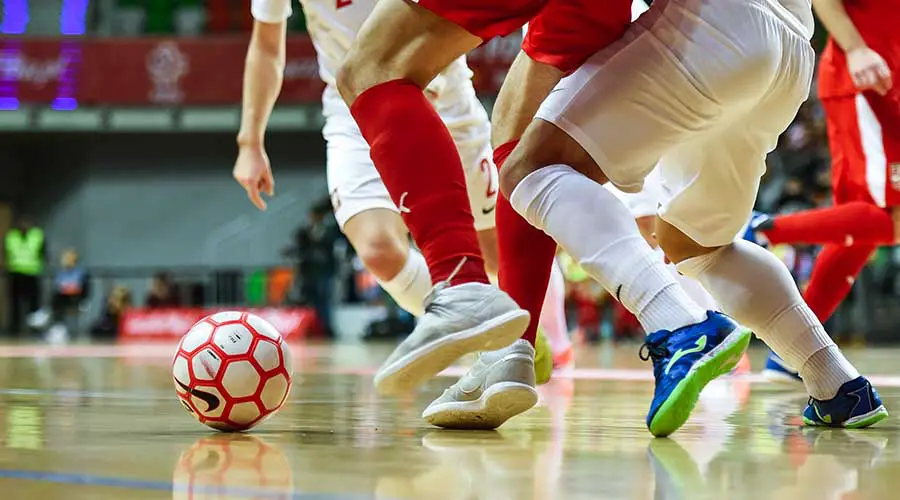
Futsal emerged in 1930 in the city of Montevideo, Uruguay. The creation of this sport is credited to Juan Carlos Ceriani, a physical education teacher at the country’s YMCA.
The motivation for conceiving this sport was related to the need to adapt traditional football to be played indoors, such as in gyms, especially during the winter months.
Juan Carlos therefore developed the rules of “indoor football”, as it was initially called, to meet this need.
The popularity of the sport quickly spread throughout South America, arriving in Brazil in the 1940s, where the sport underwent adaptations and gained even more complex rules.
Over the years, the game became more professional and increasingly structured. As a result, various championships were created, not just on the South American continent, but all over the world.
Court dimensions
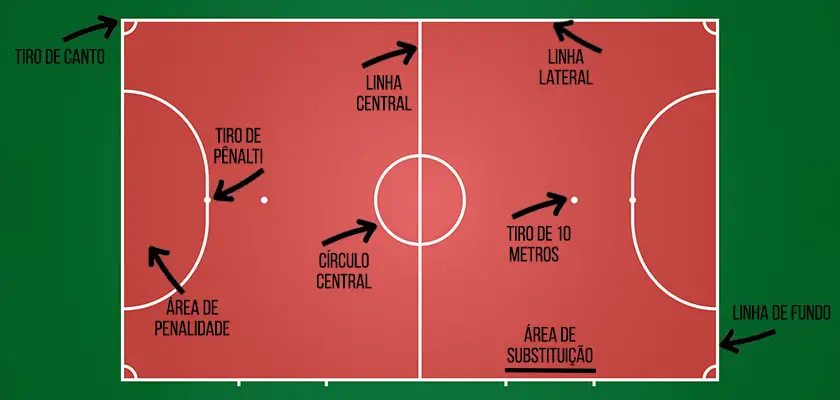
A futsal court is basically a rectangle. It can vary in size from 38 to 42 meters long and 20 to 25 meters wide.
The floor can be made of wood, cement or any solid synthetic material, as long as it is properly leveled and complies with the rules of futsal.
There are five markings on the court:
- Center line – divides the court into two parts;
- Center circle – where the game is played;
- Side lines – mark the length of the court;
- End lines – mark the width of the court;
- Penalty area – half-moon where the goalkeeper can use his hands;
- Substitution area – place where substitutions are made;
- Penalty shot – mark where penalties are taken;
- 10-meter throw – mark where 10-meter throws are taken;
- Corner kick – marking where corners are taken.
The futsal goal consists of two posts three meters wide, two meters high and eight centimeters thick. The nets, which are installed in the goals, can be made of synthetic material, rope or nylon.
What is the number of players in futsal?
In futsal, each team has a total of five players on the court, including a goalkeeper. In addition to the starters, teams also have reserves who can be substituted during the game.
Substitutions are unlimited and can be made both when the ball is stationary and when it is rolling, as long as they are made in the demarcated area of the court. It’s up to the team to choose the best moment.
How long does a futsal match last?
A futsal match lasts 40 minutes. They are divided into two periods of 20 minutes each. Before the sides change, there is a 15-minute break so that the teams can rest, hydrate and review tactics.
If a match ends in a draw, there may be an extra time divided into two five-minute periods. However, this will depend on the regulations of the championship in question.
If extra time still ends in a draw, a penalty shoot-out is held, with each team taking three penalties.
In the event of a draw in the first three penalties, alternating kicks are taken until one team misses and the other gets it right.
Futsal basic fundamentals
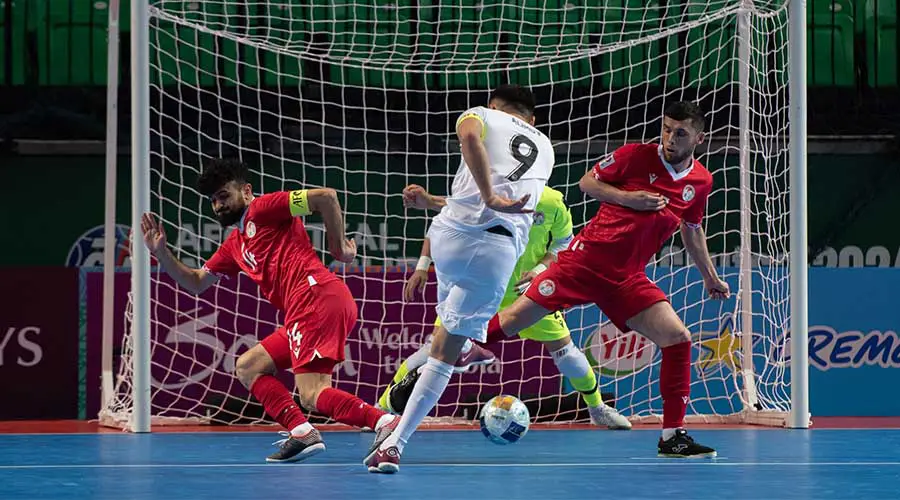
- Driving
- Movement
- Passing
- Control
- Shooting
- Heading
- Marking
- Defence
Driving
Driving is the act of moving with the ball on the court. This skill is necessary for creating moves and scoring goals.
Movement
The movement consists of moving around the court without the ball in order to open up spaces, receive passes and get the game moving.
Passing
Passing is the act of transferring the ball to a team-mate. Passes can be made from various distances and using various mechanics, such as low, over the top, at speed or with a triangle.
Control
Control consists of receiving a ball and keeping control of it, whether with your feet, thighs, chest or head.
Shooting
Shooting is the act of finalising a move with your feet, with the aim of scoring a goal. Shots can be low, high, strong or weak.
Heading
The heading consists of hitting the ball with the head, either to finish, play, dominate or clear a danger from the defence.
Marking
Marking is a defensive skill, the aim of which is to prevent the opposition from scoring. To do this, players can use a variety of tricks, such as stealing the ball, tackling, intercepting passes, blocking shots, using their bodies in a legal manner or simply keeping up with their opponents.
Defence
Finally, there is defence, which is a specific mechanic for goalkeepers. This skill consists of intercepting shots from opponents, grabbing or deflecting the ball away in order to prevent a goal. Goalkeepers can perform this action with both their hands and legs.
What are the rules of futsal?

- Fouls and violations in futsal
- Cards and expulsions
- Foul limits
- Free-kicks, corners and retakes
Fouls and violations in futsal
In futsal rules, there are basically two types of fouls: those that result in direct free kicks and indirect free kicks.
In direct free kicks, the ball is positioned where the infringement occurred and the player can shoot straight at the goal if they wish. In the case of indirect free kicks, a teammate must touch the ball before someone can shoot.
If a direct free kick infringement is committed inside the penalty area, the team that was fouled is entitled to take a penalty kick.
The direct free-kick offenses are:
- Shove your opponent;
- Jumping on the opponent;
- Throw yourself at your opponent;
- Kick the opponent;
- Locking the opponent from behind;
- Hitting the opponent;
- Assaulting the opponent;
- Pushing the opponent;
- Spitting at the opponent;
- Giving a trolley and hitting the opponent;
- Intentionally using their hand/arm on the ball;
- The goalkeeper goes out of his area with the ball in his hands.
The fouls for indirect free kicks are:
- Preventing the opponent’s advance;
- Misleading the opponent with verbal expressions;
- Assaulting a teammate;
- Obstructing an opponent’s progress;
- Preventing the goalkeeper from returning the ball with their hands;
- Touching the ball without wearing futsal equipment;
- Standing in front of the goalkeeper and obstructing his vision;
- The goalkeeper has the ball for more than four seconds;
- The goalkeeper grasps with his hands a deliberate retreat made by a linesman with his feet in normal play, from the sidelines, free kicks or corners;
- The goalkeeper may only touch the ball in the backfield once during a move. In order for him to be able to receive a rebound again, the ball must hit the opponent or the goalkeeper must be in the offensive field. If this rule is not followed, an indirect free kick is awarded;
- If the goalkeeper receives a pass in the attacking field and returns to the defending field with the ball, an indirect free kick is awarded.
Cards and expulsions
Just like in soccer, there are yellow and red cards in futsal. They are used to penalize players who don’t comply with the rules.
A yellow card is given when an athlete breaks a rule, but in a minor way, such as preventing a counter-attack, coming too hard in a tackle or deliberately putting his hand on the ball.
If a player receives a second yellow, the referee gives them a red card and they are sent off. In other words, they cannot return to the game.
The referee can also send off a player with a straight red in more serious cases, such as aggression or extremely rough fouls.
When a player is sent off, his team is down a player for two timed minutes or until they concede a goal. After that, the player who received the red can be replaced by another player from the bench.
Foul limits
In futsal rules, there is a limit of five collective fouls per period. After the sixth, the team that was fouled takes a 10-meter free kick.
It’s worth noting, however, that if the sixth (and subsequent) fouls occur closer to the goal than the 10-meter line, the kick is taken exactly where the infraction was committed.
Free-kicks, corners and retakes
When a period begins or a goal is scored, the match resumes in the middle of the center circle of the court, with the players passing the ball out.
When the ball goes out from one of the side edges, the throw-in is taken. To do this, the player places the ball on the line and uses his feet to touch it.
The ball must be completely stationary. In addition, the player may not put his entire foot into the court; at most on top of the line. Otherwise, the throw-in will be reversed and the opposing team will take the kick.
If the team is attacking and the ball goes out over the end line with the last touch being from the opposing team, the attacking team will take the corner. The mechanics are the same as for a corner kick.
If the touch comes from someone on the attacking team, the defending team will return the ball from the penalty area via the goalkeeper. Unlike field soccer, in futsal the goalkeeper does this with his hands.
Player positions
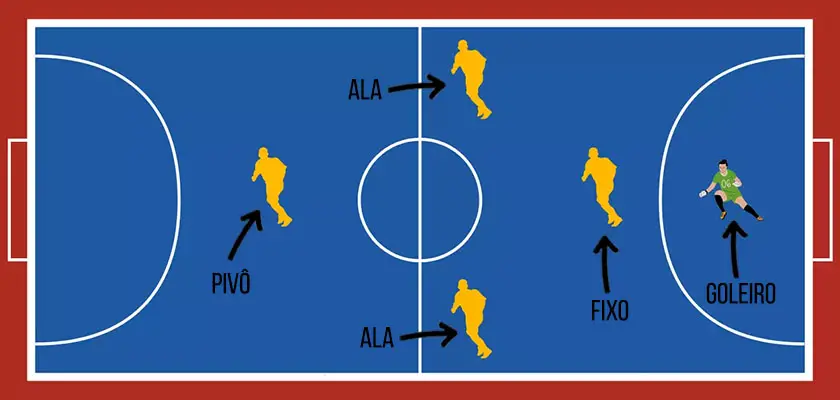
There are four positions in futsal: goalkeeper, set-piece, wing and pivot. The starting quintets are usually made up of a goalkeeper, a set-piece, two wingers and a pivot.
The goalkeeper is responsible for defending the opposition’s shots, either with his hands or his feet. They need to be tall, agile and have good reflexes.
The center back is the most defensive player in the team. He stays behind, closer to the goalkeeper, to clear the ball and start the build-up play.
The wingers work at the ends of the court, constantly moving to receive passes, break through, dribble and finish.
Finally, the pivot is the most offensive player in futsal. One of his main characteristics is to receive the ball from the back and feed the wingers.
There is also a special position called the goalkeeper line. This is used at specific moments in the match, usually when the team is down a player or in urgent need of goals.
The line keeper is a line player who takes over the goalkeeper’s position to play in the attacking half, exchanging passes and providing numerical superiority.
That’s it! Now you know everything about futsal, from its creation to the most important rules. Did you like this content? Let us know in the comments!
And don’t forget to visit us every day, eh? We publish complete and up-to-date articles every day. Just come along 👊


